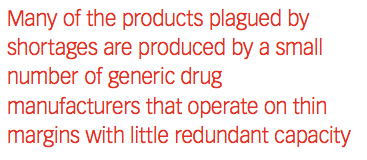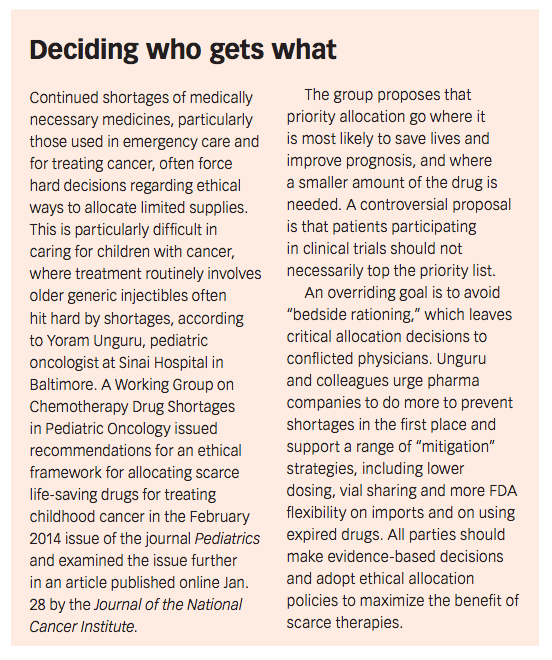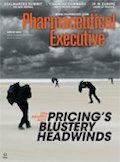Drug Shortages Raise Economic and Ethical Challenges
Pharmaceutical Executive
Analysts examine investment and business factors that shape supply disruptions.
Drug shortages have been a worldwide problem for the past decade, rising steadily until FDA, Congress and industry began to address the issue more directly about five years ago. Despite some success in reducing supply disruptions in the US and abroad, analysts are looking more closely at market-based strategies to encourage more diverse production, while physicians propose ethical standards for allocating scarce
Jill Wechsler

therapies.
FDA reports that ongoing shortages dropped from nearly 100 at the end of 2013 to about 60 a year ago, similar to findings of the American Society of Health-System Pharmacists (ASHP), which reports pharmacy data from the University of Utah Drug Information Service. A main turning point was enactment of legislation in 2012 that requires manufacturers to notify FDA in advance of likely supply disruptions for critical medicines, supporting agency efforts to prevent and resolve manufacturing issues.
Broader cooperation among regulatory authorities helps FDA’s Drug Shortages Staff (DSS) identify alternative sources for scarce critical drugs. But supply problems still are “way too many,” said Douglas Throckmorton, deputy director of the Center for Drug Evaluation and Research (CDER), at a manufacturing conference in June. The drug shortage situation “now is in a better place,” he commented, but manufacturing failings remain the lead cause of supply disruptions, particularly with sterile injectables.
Seeking incentives
Many of the products plagued by shortages are produced by a small number of generic drug manufacturers that operate on thin margins with little redundant capacity. To keep prices low, firms use common manufacturing lines for multiple products and implement 24/7 production schedules that leave little time-cushion to address production problems. At the same time, sterile therapies are more complex and expensive to produce than oral drugs, and low profit margins discourage firms from investing in facility updates or for other companies to move into the market.
As a result, clinicians and patients still struggle with limited supplies of basic therapies such as cardiovascular drugs, electrolytes, and injectables used in emergency rooms and intensive care units. Vaccine shortages emerge regularly, the latest involving limited supplies of yellow fever vaccine in the face of a spreading epidemic in Africa.
Shortages of drugs needed for acute care in emergency rooms and ICUs are particularly serious, according to a study published in the May issue of Health Affairs. It found that more than half of nearly 2,000 drug shortages reported between 2001 and 2014 to the University of Utah data system were for acute-care drugs where shortages pose a high risk of patient harm. The authors from the Yale School of Medicine identify particular difficulties in finding alternatives to scare antibiotics, painkillers, sedatives and saline intravenous solutions used daily in critical care. Substitutes, moreover, often are less effective, less safe, and more

prone to medication errors during emergency care.
FDA should do more to identify generic injectables produced by a single source and, thus, at risk of supply problems, the analysts advise. They also recommend using tax credits, rebates or temporary market exclusivity policies to encourage more generic firms to move into difficult injectable markets.
Similarly, the World Health Organization (WHO) released a report in January on global shortages of critical medicines for children, which addresses business and competitive factors that reduce access to low-cost injectables. WHO suggested that setting minimum prices or establishing multi-year global advance purchase commitments could help keep vital medicines on the market.
Broader interest in the economic drivers behind drug shortages has prompted the Pew Charitable Trusts and the International Society for Pharmaceutical Engineering (ISPE) to examine market issues affecting business continuity and supply chain management decisions and investments that can affect drug supplies. The project is interviewing key industry stakeholders on how factors such as market concentration, low margins and product withdrawals affect shortage situations. An ISPE “gap tool” further aims to help manufacturers avoid shortages by anticipating potential supply

chain risks, improving product demand forecasting and providing redundancy in production operations.
Early warnings help
Despite ongoing drug supply issues, FDA’s advance notification program appears helpful in preventing and mitigating problems. Throckmorton reported that manufacturers are submitting about 200-300 reports of potential supply issues annually, which enabled FDA to avert about 150 drug shortages last year. And FDA has had to issue only two non-compliance letters so far to firms failing to provide adequate warning.
After a manufacturer informs FDA of a likely shortage, CDER’s DSS, headed by Valerie Jensen, assesses the risk of disruption and helps devise mitigation strategies, working with drug approval and quality offices and with the Center for Biologics Evaluation and Research (CBER) and FDA’s Office of Regulatory Affairs (ORA). The analysts first determine if the product is medically necessary and check for any applications under review that could help fill a gap.
They also assess alternative sources of supply and whether a facility with potential to provide a needed drug meets quality standards or requires a new inspection.
FDA officials also can exercise enforcement discretion to facilitate access to new sources of critical drugs, as seen in import alerts that exempt medically necessary drugs and short supply situations. And they are working to gain more flexibility in authorizing imports of unapproved therapies.
A current issue is whether greater variety in vial sizes for injectables could help reduce waste, especially when a large vial is not needed by a patient, as is often the case with children. Oncologists claim that pharma companies avoid small vials to boost sales and profits, but the ability of smaller vials to help address supply and access issues may be more compelling in addressing the subject.
Jill Wechsler is Pharmaceutical Executive’s Washington correspondent. She can be reached at jill.wechsler@ubm.com

Navigating Distrust: Pharma in the Age of Social Media
February 18th 2025Ian Baer, Founder and CEO of Sooth, discusses how the growing distrust in social media will impact industry marketing strategies and the relationships between pharmaceutical companies and the patients they aim to serve. He also explains dark social, how to combat misinformation, closing the trust gap, and more.